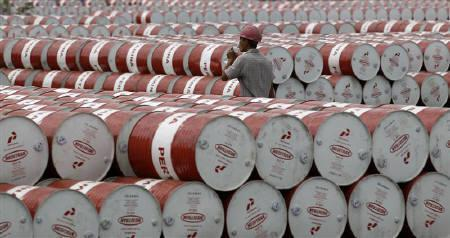It was the first time in 18 months that refinery throughput exceeded the amount of crude available from imports and domestic production.
Refiners processed about 30,000 barrels per day (bpd) more in the January-February period than the total of crude available, according to calculations based on official data.
China does not disclose the volumes of crude flowing into or out of strategic and commercial stockpiles, but an estimate can be made by deducting the amount of oil processed from the total of crude available from imports and domestic output.
Refiners processed the equivalent of 14.74 million bpd in the first two months of the year, up 2.1% from the same period a year earlier, according to data released on Monday by the National Bureau of Statistics.
China combines import data for January and February to smooth out the impact of the week-long Lunar New Year holiday, the timing for which changes each year.
China, the world’s biggest crude importer, saw arrivals of 10.37 million bpd in the first two months of the year, and domestic production of 4.34 million bpd.
The combined total of 14.71 million bpd was 30,000 bpd below the volume processed, the first time since September 2023 that processing exceeded available crude.
Given that it’s a relatively rare occurrence for refiners to process more crude than the total of imports and domestic output, it’s worth asking why this was the case for the first two months of 2025.
The main reason is that crude imports were weak in the first two months, dropping 5% from the same period in 2024.
There were likely two main factors behind the decline in imports, the first being that refiners cut back on cargoes from Russia after outgoing U.S. President Joe Biden imposed new sanctions in mid-January on tankers carrying Russian crude.
But it’s also worth noting that refiners didn’t appear to make much effort to replace Russian oil with cargoes from other suppliers, and the most likely reason for that was the strength of global crude prices in January and February.
Benchmark Brent futures reached their highest point so far this year of $82.63 a barrel on Jan. 15, having risen steadily from levels around $70 at the start of December.
PRICE PULLBACK
China’s refiners have a track record of paring imports when they believe oil prices have risen too high, or too quickly.
The last time they dipped into inventories in September 2023 came after crude prices had rallied strongly from around $72 a barrel in June of that year to reach a 10-month high of $96.26 on Sept. 29, 2023.
Crude prices have been retreating since their high in January this year, with Brent trading around $71.00 a barrel in Asian trade on Monday.
The decline in prices may be enough to encourage refiners to buy more crude, but this will likely only show up in imports from April onwards given the lag between when oil is ordered and physically delivered.
On the refinery processing side of the equation, it’s worth noting that while throughput rose 2.1% in the first two months of the year from the same period in 2024, it was still well short of what used to be normal levels.
China’s refinery processing fell in 2024 for the first year in more than two decades, dropping to 14.13 million bpd.
The recovery to 14.74 million bpd in the January-February period is modest, especially when viewed against the period from August 2023 through to March 2024, when processing volumes regularly exceeded 15 million bpd.
Refinery processing was also likely boosted by increased gasoline demand for the Lunar New Year holidays, and by the start up of a 200,000 bpd unit at the new Shandong Yulong Petrochemical refinery.
The views expressed here are those of the author, a columnist for Reuters.
Editing by Kate Mayberry – Reuters




